Information in the review is provided as of April 1, 2024
Summary.
The combat readiness inspection was the main event of March in the Belarusian Armed Forces. As part of the inspection, they practiced the mobilization expansion of two brigades – a mechanized brigade and an anti-aircraft missile brigade. In terms of its scale and the number of reservists drafted, this inspection is the largest such event in recent years. Currently, these activities don’t pose a direct military threat to Poland and the Baltic states.
The level of presence of the Russian Armed Forces didn’t change in March. There may be about 2000 Russian military personnel in Belarus. The activity of units of the Russian Armed Forces stationed in Belarus remains very low.
PMC Wagner mercenaries are still stationed in Belarus, they continue to train enforcers of the Lukashenka regime. Their number might be estimated at hundreds of people.
The general medium-term forecast of the military situation in Belarus remains the same. Currently, there is no reason to expect an offensive by the Russian Armed Forces from the territory of Belarus, as well as an increase in their military presence. Involvement of the Belarusian Armed Forces in combat operations against Ukraine is still unlikely. The significance of PMC Wagner as a destabilizing factor no longer exists.
1. Armed Forces of the Republic of Belarus
1.1. Organization of combat training.
March was full of a large number of combat training activities. The most significant of them was the combat readiness inspection of the Belarusian Armed Forces (for more details, see paragraph 1.11 of the review).
We note that the beginning of spring is traditionally a period when field drills are actively conducted. Field drills were reported:
At the Obuz-Liasnouski training ground – with the 105th Separate Mechanized Battalion of the 11th Mechanized Brigade, the 350th Artillery Group of the 6th Mechanized Brigade, the 841st Artillery Group of the 11th Mechanized Brigade, and the 111th Artillery Brigade.
At the Hozhski training ground – with the 202nd Mechanized Battalion and the Radiation, Chemical and Biological Protection Company of the 6th Mechanized Brigade, the 557th Engineering Brigade and other engineering units of the Western Operational Command, and a divizion of the 1st Anti-Aircraft Missile Regiment.
At the Asipovichski training ground – with the 191st Artillery Group of the 19th Mechanized Brigade, the 310th Artillery Group of the 120th Mechanized Brigade, the 51st and 231st Artillery Brigades.
At the 174th Damanava training ground of the Air Force and Air Defense Forces – with air defense units of the Western Operational Command (anti-aircraft missile and artillery divizions of the 6th and 11th Mechanized Brigades and units of the 147th Anti-Aircraft Missile Regiment).
At the Brestski training ground – with a divizion of the 115th Anti-Aircraft Missile Regiment.
At the Losvida training ground – with the communication units of the 103rd Airborne Brigade, etc.
A number of company and battalion tactical drills were also reported.
Significant combat training activities include the following:
1) In March, combat trainings with the 40th Separate Mechanized Battalion of the 11th Mechanized Brigade and the 78th Separate Mechanized Battalion of the 6th Mechanized Brigade were conducted at the “resistance node of the Kobryn fortified area” located in the vicinity of Saki village, Zhabinka district. Such trainings are conducted regularly with motorized rifle units of the Western Operational Command.
2) On March 6, a methodological training session with servicemen of the Belarusian Armed Forces, who had been trained as instructors at the 333rd combat training center of the Russian Armed Forces, was held at the Lepelski training ground. The participants of the training session were shown elements of firearms and tactical training, tactical medicine, mine and explosives operations, and the use of UAVs and communications equipment. Special attention was paid to individual training with emphasis on the autonomy of servicemen in combat conditions.
3) On March 14, a comprehensive inspection involving the 50th Combined Air Base, 61st Fighter Air Base and 116th Assault Air Base of the Belarusian Air Force. The Ministry of Defense of Belarus didn’t report on these events.
4) Tactical drills with live firing were conducted with the howitzer divizion of the 51st Artillery Brigade at the Asipovichski training ground. During the drills, for the first time they practiced hitting a target with the Krasnopol adjustable artillery shell using target designations from the Russian-made Orlan-30 UAV.
5) On March 25-29, control exercises on tactical and special training were conducted in the Signal Troops. During the exercises, servicemen practiced practical measures to build up and operate the communications system of the Belarusian Armed Forces. New forms and methods of organizing communications and the combat use of communications units were tested, taking into account the experience of modern armed conflicts.
6) On March 27, the 61st Fighter Air Base and the 116th Assault Air Base redeployed their aircraft to reserve airfields. During the training, the pilots practiced the transfer of aircraft to Minsk National Airport and Babruisk airfield.
7) A training session with instructors on tactical shooting was held in the Western Operational Command.
Training of Belarusian military specialists in Russia.
Belarusian military specialists continue to be trained at training centers on the territory of Russia.
1) A group of servicemen of the Belarusian Armed Forces is being trained as snipers at the 56th training center for junior specialists of the motorized rifle troops of the Russian Armed Forces.
2) On March 18, servicemen of the 7th Tank Battalion of the 11th Mechanized Brigade went to the 333rd combat training center (Mulino, Nizhny Novgorod oblast, Russia) for joint training with servicemen of the Russian Armed Forces. This is not the first group of the Belarusian military to be trained at the 333rd center. Previously, servicemen of motorized rifle and tank units of the Belarusian Armed Forces have already been trained there. Usually, the training course lasted about a month. During the training, the servicemen improve their skills in tactical shooting and medicine, evacuation from armored vehicles that have been hit, and self-digging of a tank. The training is conducted using T-72B3 tanks.
Special forces units, Internal Troops.
On March 13, a joint special tactical training on releasing hostages and apprehending armed criminals was held with members of the Almaz special anti-terrorism unit of the MIA of Belarus and the Rys’ special rapid reaction unit of Rosgvardiya. During the joint training, members of the Russian special unit shared their experience of combat operations in Ukraine.
A joint training session between the 22nd Separate Special Forces Company of the Belarusian Armed Forces and the Special Rapid Response Unit (SOBR) of the Internal Troops was conducted in March. During the training, they practiced issues of interaction in the joint conduct of counter-sabotage operations. The servicemen exchanged experience of operations in a forested and swampy area and in a settlement.
Training of Belarusian enforcers by PMC Wagner mercenaries.
Training of servicemen by PMC Wagner mercenaries continued in March.
The mercenaries continue to train servicemen of the Internal Troops. On March 14, the seventh course of training of servicemen of the Internal Troops by the mercenaries of PMC Wagner was completed. The training lasted for three weeks. It was attended by more than 150 people. It was also reported about the participation of mercenaries in the conduct of coordination of the Granit special forces unit of the Internal Troops. It is notable that officially the Internal Troops press service stopped mentioning PMC Wagner in its materials. Since early February, the mercenaries have been referred to simply as “experienced instructors”.
From July 2023 to March 2024, more than two thousand servicemen and cadets of the Internal Troops Faculty underwent training with PMC Wagner mercenaries.
Training also continued with the Belarusian Armed Forces. For example, on March 1, servicemen of the 78th Separate Mechanized Battalion of the 6th Mechanized Brigade completed a training course with PMC Wagner mercenaries at the Obuz-Liasnouski training ground. The battalion returned to the permanent deployment point. The 105th Separate Mechanized Battalion of the 11th Mechanized Brigade started training with the mercenaries instead. Telegram channels of military units of the Belarusian Armed Forces also name the mercenaries “experienced instructors”. The Ministry of Defense of Belarus didn’t report on these trainings. The mercenaries were also involved in the conduct of trainings with reservists drafted into the 19th Mechanized Brigade as part of the combat readiness inspection. Unlike the previous trainings, the Ministry of Defense of Belarus reported on them.
Thus, the involvement of PMC Wagner mercenaries in the organization of combat training remains systematic.
1.2. Movements of military equipment and aviation activity.
The intensity of movements of military equipment increased almost threefold compared to February. This is due to two reasons: 1) the beginning of the combat readiness inspection of the Belarusian Armed Forces; 2) active conduct of combat training activities at training grounds (primarily field drills).
As in previous months, there was nothing unusual in movements of the equipment of the Belarusian Armed Forces. Most of the movements are concentrated in the vicinity of the areas where the garrisons and training grounds of the Belarusian Armed Forces are located. At the same time, some forces and means were redeployed to the western border of Belarus as part of the combat readiness inspection (for more details, see paragraph 1.11 of the review). No concentration of the troops in close proximity to the southern or western border of Belarus is recorded. More details on the movements of military equipment are available on the map of military activity.
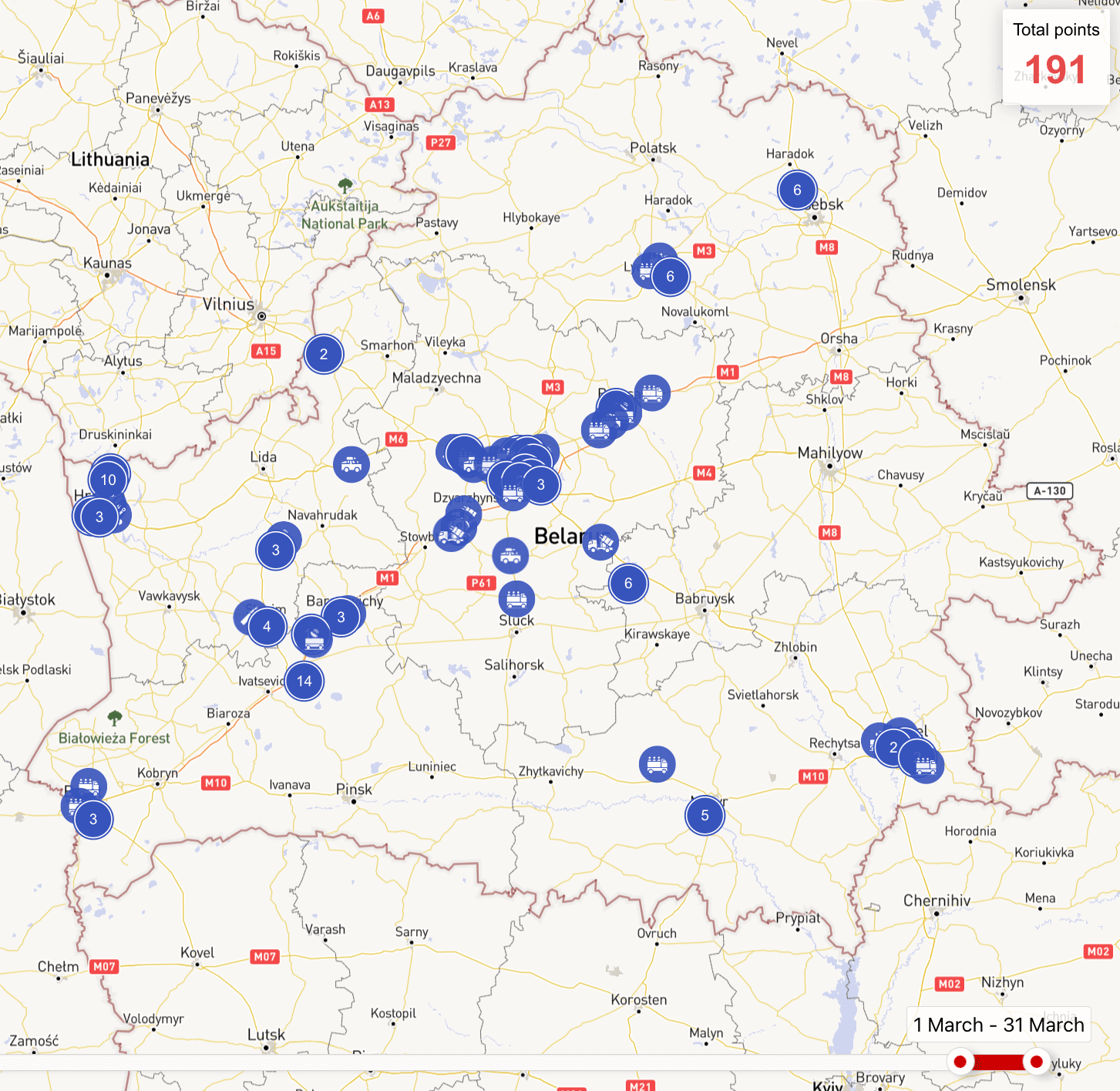
The intensity of movements of the Belarusian Armed Forces by rail increased threefold compared to February. This is due to active combat training activities (including field drills and the combat readiness inspection).
The intensity of flights of the Belarusian Air Force increased by one third compared to February. Lida, Baranavichy and Machulishchy airfields were mainly used for flights, while Vosautsy, Luninets and Babruisk airfields were used less frequently. The increase in the intensity of flights was influenced, among other things, by the combat readiness inspection of the Belarusian Armed Forces. The entire helicopter and aircraft fleet of the Belarusian Air Force was involved in the flights.

Other notable features of aviation activity include:
1) During the month (on March 6, 14-16, 18-22, 29 and 31), flights of helicopters of the Belarusian Air Force were repeatedly recorded in the area of the state border with Poland.
2) On March 14, for the first time in several months, a Mi-8 helicopter of the Belarusian Air Force flew to the so-called “Site 400. Kupol” (located near Volma village, Minsk district). The helicopter picked up passengers there and then flew to Mazyr (Bokau) and Ziabrauka airfields, where the Russian military are deployed. Also, on March 15, a Mi-8 helicopter of the Belarusian Air Force flew to “Site 400. Kupol” and then to Luninets airfield. We recall that a command center of the Russian Armed Forces group, which began the invasion of Ukraine from the territory of Belarus, was deployed there. In turn, units of the 1530th Anti-Aircraft Missile Regiment of the Russian Armed Forces are stationed at these airfields (except for Luninets airfield) (for more details, see paragraph 2.2 of the review).
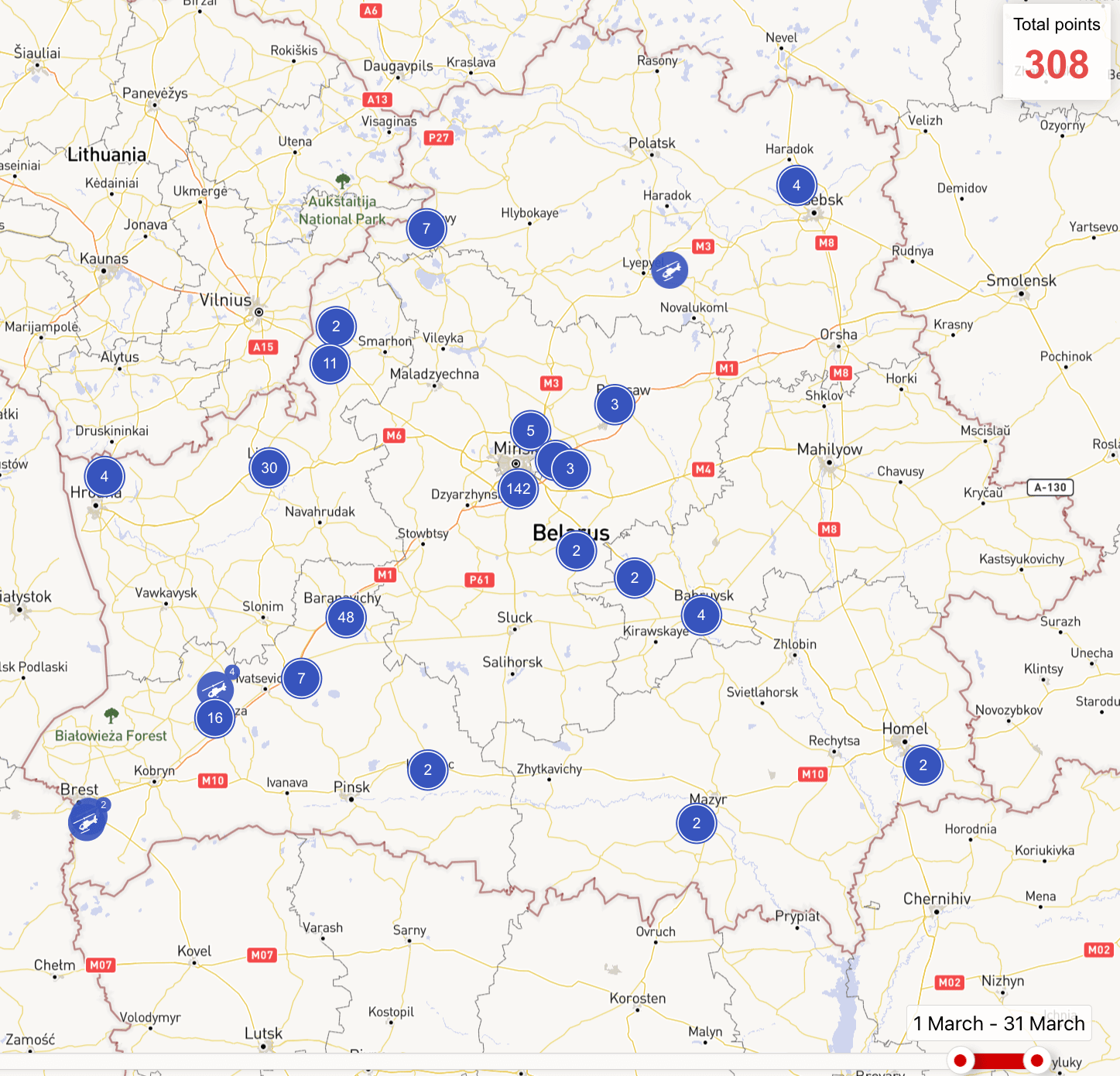
3) The flight restriction zone for all types of civil aircraft (including UAVs) in the south of Belarus was extended in accordance with NOTAMN O0159/24 from 00:00 of April 1 to June 30. The ban on flights over the southern part of Belarus was introduced on February 24, 2022, with the beginning of Russia’s full-scale invasion of Ukraine. This means that the potential threat of missile strikes from the territory of Belarus still exists.
1.3. The Belarusian Armed Forces group deployed in the regions bordering Ukraine.
Units of the Special Operations Forces are still present in the regions of Belarus bordering Ukraine. Despite the fact that the military are officially declared to be carrying out border protection tasks, they also cover Russian military facilities in Homiel region.
Units of the Special Operations Forces will be stationed in Mazyr and Homiel districts until the end of 2024. Also, field drills of units of the Special Operations Forces will be conducted near Luninets airfield (Brest region) until the end of this year. The 56th Anti-Aircraft Missile Regiment of the Belarusian Armed Forces (military unit 10198) is deployed at the airfield.
Thus, until the end of 2024, units of the Special Operations Forces will guard the deployment sites of the air defense units of the Belarusian Armed Forces and Russian Armed Forces located in the southern regions of Belarus – at Luninets, Mazyr and Ziabrauka airfields.
As of the end of March, the 383rd Separate Air Assault Battalion of the 38th Air Assault Brigade was deployed in the vicinity of Ziabrauka airfield (Homiel district) instead of one of the battalions of the 103rd Airborne Brigade (military unit 92900). Their rotation took place in late February/early March. On average, rotations are conducted every two months.
In turn, units of the 5th Special Forces Brigade are still stationed in the vicinity of Mazyr. This is confirmed by the data on movements of military equipment. For example, of the Bogatyr vehicles (Dongfeng Mengshi EQ2050F), which are in service with the Special Operations Forces units.
The total number of these units can be estimated at 400-500 people.
There’s been no information about the concentration of other units near the border with Ukraine.
We note that permanent deployment points of a number of units of the Belarusian Armed Forces, as well as the border guard service and the Internal Troops, are located in areas of Brest and Homiel regions bordering Ukraine. The locations of their deployments haven’t changed. It should be noted that in March a new border outpost was established in the Mazyr Border Guard Detachment (for more details, see paragraph 1.7 of the review).
Currently, there are no grounds to say that the Belarusian Armed Forces group near the border with Ukraine may increase in size. The number of units located there is static.
1.4. Military commissariats. Territorial defense and national home guard.
As we had previously suggested, drills with the territorial defense and national home guard were to be expected in March.
For example, on March 12, the inspection of the territorial defense of Homiel region began. Its purpose is to determine the level of readiness of local authorities to establish territorial troops. As part of the inspection, 200 reservists were drafted in Rahachou and Karma districts.
Also, from March 14 to April 5, a training session was held in Voranava district (Hrodna region) with conscripts of the territorial troops. 100 reservists were drafted during the drills.
Training sessions with the territorial troops usually include the conscription of reservists and their training in military occupational specialties. The training ends with command-staff drills. The drills include the protection and defense of critical infrastructure facilities, duty at checkpoints, countering sabotage and reconnaissance groups of a conditional enemy, etc.
According to available information, in April, drills with the territorial defense will take place in Vileika district of Minsk region, and in May – in Mahiliou.
Thus, drills with the territorial defense are already being conducted in three regions of Belarus, and are scheduled to take place in two more.
Other significant events include the following:
1) On March 4-7, mobilization readiness training with territorial defense authorities was held all over Belarus. Within four days, theoretical and practical activities were conducted with officials of executive committees and military commissariats, administrations of mobilization resource reception points, as well as with conscripts. Such trainings are held twice a year.
2) On March 14, a training on conducting mobilization activities was held in Shklou district (Mahiliou region) with servicemen of military commissariats of the region.
3) On March 20-22, a joint mobilization training was held in Brest region. The training involved the personnel of the military commissariats of the region. The purpose of the training was to improve the knowledge and skills of officials in the issues of notification and conscription of persons liable for military service. Within the framework of the training, exercises with conscripts were conducted.
4) On March 27-28, under the leadership of the chairman of the Talochyn District Executive Committee, a joint training was conducted with the district territorial defense headquarters. Officials of the military commissariats of Vitsiebsk region, representatives of the inspection for the protection of fauna and flora, police and the Ministry of Emergency Situations took part in the training. The purpose of the training is to maintain the level of coordination of the territorial defense management bodies. Such training was also conducted in Vitsiebsk.
More than 1500 people joined detachments of the national home guard in Minsk district, of whom about 10% are women. The local district executive committee adopted a decision based on the Law “On national home guard”, which defines the list of detachments of the national home guard, their number and locations. Training was organized for them.
In March, at least 12 court verdicts were reported in criminal cases against citizens who evaded conscription for active military service (Article 435 of the Criminal Code). This is not a final figure yet, as sentences are published in the public domain with a delay. This is almost three times less than the number of verdicts given in March 2023.
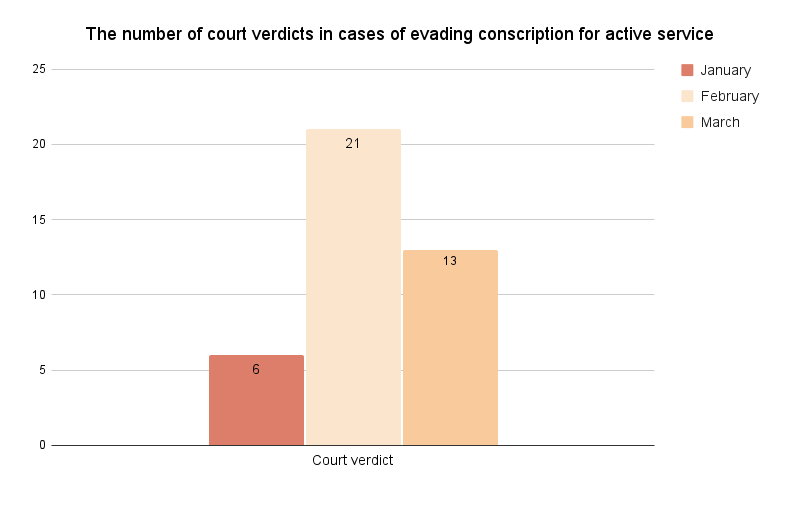
In March, it was reported that measures were taken to organize the spring conscription for active military service. As for the results of the fall-2023 conscription, a representative of the main organizational and mobilization department of the General Staff said that the demand of the Belarusian Armed Forces for conscripts was fully met. At the same time, there is a shortage of conscripts in certain specialties (it was not specified which ones).
The publication of local budgets has been completed, which allows to analyze the planned expenditures on national defense. Thus, the total amount of expenditures on national defense of all budgets of Homiel region was about $1.6 million for 2024. This is 37% more than in 2023. The planned expenditures will allow not only to finance the current activities of local authorities in the national defense sphere, but also to continue investing in it.
1.5. Military training sessions with reservists.
The available information allows us to state that in March 2024, the largest number of reservists in recent years were simultaneously drafted to military training sessions.
As part of the combat readiness inspection (for more details, see paragraph 1.11 of the review), the following number of reservists drafted:
- to the 19th Mechanized Brigade – about 5000 people;
- to the 120th Anti-Aircraft Missile Brigade – about 1000 people.
It was also reported that training sessions with reservists were conducted in:
- the 1146th Anti-Aircraft Missile Regiment (at least 10 reservists);
- the 6th, 11th and 120th Mechanized Brigades;
- the 74th Signal Regiment;
- the 557th Engineering Brigade;
- the 2400th Separate Signal Battalion;
- the 25th Rocket and Artillery Weapons Arsenal;
- the 83rd Engineering Airfield Regiment;
- the 4970th Engineering Ammunition Storage Base;
- the 7th Engineering Regiment;
- the 115th Anti-Aircraft Missile Regiment;
- Military Academy.
A total of at least 221 reservists were drafted to the training sessions in these units.
There was information that military commissariats of Minsk and Brest regions, as well as Minsk city, sent reservists to military training sessions – a total of at least 139 reservists. According to the clarified information, in February, military commissariats of Minsk region drafted reservists (at least 5 people) to military training sessions.
Also, about 300 people were drafted to training sessions of the territorial troops in Homiel region and Voranava district.
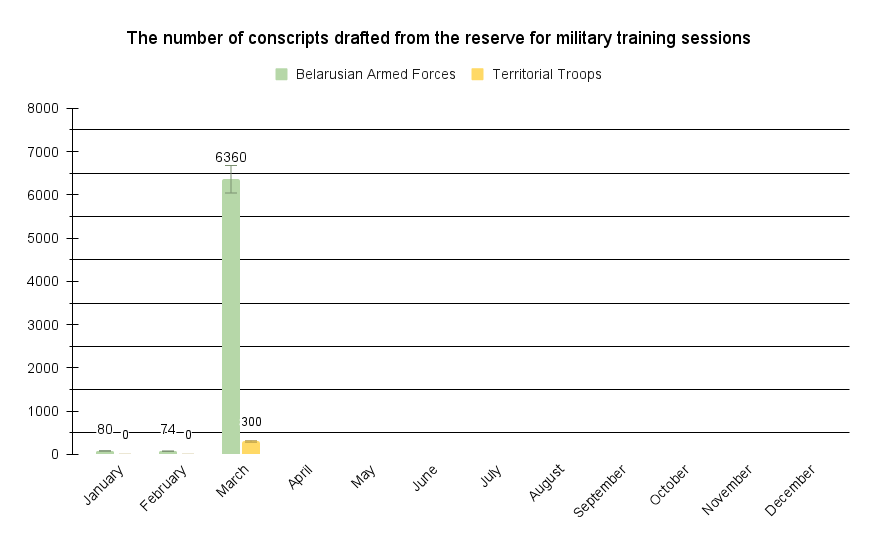
Thus, the total number of reservists drafted to military training sessions in March can be at least 6660 people. We note that this is the minimal number of reservists who have undergone military training sessions. In reality, their number may be several times higher, since open sources publish only fragmentary data on conscription to military training sessions.
The Ministry of Defense of Belarus hasn’t reported the number of conscripts to be drafted to military training sessions in 2024. A total of 9000 people were planned to be drafted to training sessions in 2023.
1.6. Rearmament and activity of the military-industrial complex.
Supplies of new military equipment to the troops.
The following new equipment was reported to be delivered to the troops in March:
1) Repair units of the Special Operations Forces received seven pieces of equipment. These include REM-KL repair and evacuation vehicles and Russian-made MTO-UB1 maintenance workshops.
2) The 50th combined air base (Machulishchy airfield) will receive eight pieces of ground maintenance equipment in the near future. The purchase may be related to plans to increase the number of aircraft of the Belarusian Air Force, which will be deployed at Machulishchy airfield.
Plans on rearmament were also announced:
1) According to the state procurement plan for 2024, the Ministry of Defense of Belarus is planning to purchase 13 Supercam S350 UAVs. Most likely, at least part of the drones planned for purchase will be sent to artillery units.
2) According to state media, the 377th Anti-Aircraft Missile Regiment of the Belarusian Armed Forces will be rearmed with modern air defense systems. The regiment will receive S-400, Tor-M2 and Pantsir-S1 SAM systems. No timeline for the rearmament was mentioned.
Activity of the military-industrial complex.
1) Work on the development of the Klyon short-range reconnaissance radar continues.
2) Field tests of the modernized 9A33-2B combat vehicle of the Osa SAM system were completed. The modernization of the Osa SAM system is being carried out at the 2566th Radio-Electronic Weapons Repair Plant located in Barysau. No plans to transfer the modernized Osa SAM system to the Belarusian Armed Forces were reported.
3) The State Authority for Military Industry has completed tests of the 122-mm BM-21B BelGrad-2 MLRS, developed by the 2566th Radio-Electronic Weapons Repair Plant. The tests confirmed that the characteristics of the BM-21B meet the requirements of the design documentation and that the combat vehicle is ready for serial production for further delivery to the Belarusian Armed Forces within the State Defense Order.
4) An enterprise of the State Authority for Military Industry has completed state tests of self-propelled artillery gun control sets, based on the results of which the products were adopted by the order of the Minister of Defense of Belarus. The set provides for a 1.5-2 times reduction in the time required to perform a firing task.
Transfer of Belarusian military-industrial complex products to Russia.
The Russian military started operating Belarusian-made MAZ-6317 trucks. This conclusion is based on information spread by one of Z-channels. Apparently, large losses in equipment and the inability of the industry to meet all the needs forced the Russian military to start purchasing MAZ trucks in Belarus. The scale of purchases is unknown.
1.7. Development of military infrastructure. Formation (re-organization) of new units. Training of military personnel
Development of military infrastructure.
1) On March 14, a new border outpost “Baravoye” was opened in Lelchytsy district. The outpost became the second one opened this year on the Belarus-Ukraine border.
2) The command of the Air Force and Air Defense Forces is planning to purchase 1000 airfield slabs to repair the runways at Machulishchy and Baranavichy airfields. We note that the replacement of the runway pavement is carried out annually on small sections. For example, the number of slabs purchased for Machulishchy airfield in 2024 should be enough to replace the pavement of about 150 meters of the runway.
Formation (re-organization) of new units.
1) The Special Rapid Response Unit (SOBR) was transformed into the Special Purpose Center of the Internal Troops.
2) According to Lukashenka’s decree, the Berkut special purpose detachment has been given the status of a separate military unit. Now it is the Berkut special purpose detachment, military unit 5528. Changes in the organizational and staff structure and the introduction of new positions for warrant officers and officers continue in the Internal Troops. In total, more than 530 new positions have already been introduced.
Training of military personnel.
On March 29, a graduation of students of junior officer training courses took place at the Faculty of Internal Troops of the Military Academy. More than 35 servicemen graduated from the course. They were awarded the first officer rank of junior lieutenant.
1.8. Tactical nuclear weapons.
In mid-March, the media, citing the Federation of American Scientists (FAS), reported that the equipment of an additional security perimeter was completed at one of the artillery bases of the Belarusian Armed Forces. From this it was concluded that nuclear warheads for Iskander systems could be stored on the territory of the base.
We are talking about the 1405th base of artillery ammunition of the Belarusian Armed Forces (military unit 42707), located in the vicinity of Vialikaya Harozha village, Asipovichy district. According to our information, in 2022-2023, an additional security perimeter consisting of four lines of fencing was indeed equipped in the northern part of the base. At the same time, the Federation of American Scientists assumes, but does not assert, that TNWs are deployed on the territory of the 1405th base. Construction activity at the facility is alarming and requires additional analysis.
Currently, there is still no reliable data that would confirm the presence of TNWs on the territory of Belarus. Political statements regarding TNWs in Belarus made by Lukashenka, his officials and ‘experts’ can’t be trusted.
1.9. Amendments to legislation in the military sphere.
On March 4, a decree “On transferring state bodies and other organizations to work in wartime conditions” was signed. The document improves the procedure for transferring state bodies from peacetime to wartime work, ensuring their coordinated and effective interaction in case of threats to national security, taking into account changes in military and political conditions. The full text of the decree hasn’t been published.
1.10. International cooperation.
1) On March 4, the Chief of the General Staff of the Armed Forces of Uzbekistan paid an official visit to Belarus. During the visit, negotiations were held with the Minister of Defense of Belarus and the Chief of the General Staff of the Belarusian Armed Forces.
2) On March 4-6, a Belarusian military delegation took part in the DIMDEX-2024 international defense exhibition in Doha (Qatar). Within the framework of the exhibition, a representative of the Belarusian delegation met with the Chief of Staff of the Armed Forces of Qatar.
3) On March 17, Viktar Hulevich, the Chief of the General Staff of the Armed Forces, went on an official visit to the Republic of Cuba. During the visit, negotiations with the Minister of Defense of Cuba and the Chief of the General Staff took place. The parties exchanged views on the issues of deepening mutually beneficial areas of military cooperation and confirmed their interest in further strengthening of the Belarus-Cuba partnership.
4) On March 26, the Zimbabwean Defense Attaché paid an official visit to the Ministry of Defense of Belarus due to his appointment. The parties discussed the implementation of the ‘Roadmap’ for the development of cooperation, as well as the Action Plan for Military Cooperation between the Ministries of Defense of Belarus and Zimbabwe for 2024.
5) On March 27, the head of the Department of International Military Cooperation in Abu Dhabi held a bilateral meeting with a representative of the Ministry of Defense of the United Arab Emirates. The parties discussed issues of bilateral cooperation in the military sphere and also agreed on a list of joint activities for 2024. Based on the results of the meeting, the parties expressed interest in intensifying contacts in the military sphere.
6) On March 27, Commander of the Internal Troops Mikalai Karpiankou met with Liu Zhe, military attaché at the Chinese Embassy in Belarus. During the meeting, the issues of further development of the relationship between the agencies were discussed. An agreement was reached on mutual training of servicemen.
1.11. Combat readiness inspection.
The 19th Mechanized Brigade.
On March 11, the Belarusian Armed Forces started the combat readiness inspection of the Belarusian Armed Forces. Officially, the inspection is a response to the NATO Steadfast Defender 2024 and Dragon-24 drills. The 19th Mechanized Brigade (military unit 71327) plays the main role in the inspection. The brigade was involved in the inspection in two stages.
During the first stage of the inspection, the brigade’s rapid reaction units (a mechanized battalion reinforced by a tank company) were redeployed to Ashmiany district (Hrodna region) and Pastavy district (Vitsiebsk region) to cover a section of the state border. The choice of units’ deployment is not a coincidence, as the Northwestern Operational Command is responsible for covering the Baltic direction.
On March 15, the second stage of the 19th Mechanized Brigade’s inspection began, which included bringing the entire brigade to full readiness. To staff the units of the 19th Mechanized Brigade, conscription from the reserve began. A total of 5000 reservists were drafted. There is also a draft of vehicles from organizations. The number of drafted reservists is sufficient to carry out the mobilization expansion of the 19th Mechanized Brigade to wartime staffing strength. Similar activities were carried out in 2023 with the 11th Mechanized Brigade.
Training on basic combat training disciplines is being conducted with the conscripts. The training is conducted by instructors trained in Russia and by mercenaries of PMC Wagner.
After the brigade is brought to full combat readiness, brigade tactical drills will be held to test the level of training of the units during the performance of combat training tasks.
Some units of the 19th Mechanized Brigade staffed by reservists have begun moving to training grounds for drills. The main part of the brigade’s forces and means is still concentrated at the Lepelski training ground and in Zaslonava (permanent deployment point of the 19th Mechanized Brigade).
The 120th Anti-Aircraft Missile Brigade
On March 25, the Ministry of Defense of Belarus reported that the 120th Anti-Aircraft Missile Brigade (military unit 96577) was brought to readiness to perform its assigned tasks. The brigade is deployed in Baranavichy and has Buk SAM systems. In order to additionally staff the brigade to the wartime staff size, military commissariats of Brest region drafted about 1000 conscripts to military training sessions. Military equipment was removed from long-term storage. Some units of the brigade were taken to the assigned areas and started their combat duty. Combat training is conducted at the 174th Damanava training ground of the Air Force and Air Defense Forces with conscripts drafted from the reserve.
Units of the Western Operational Command.
Some units of the Western Operational Command also took part in the inspection. Two mechanized battalions, two artillery divizions and a mortar battery were involved in the inspection. In total, about 850-900 personnel, 62 armored combat vehicles, 110 vehicles and 30 artillery systems. The units performed tasks at the Hozhski and Obuz-Liasnouski training grounds.
2. Armed Forces of the Russian Federation
2.1. Russian group in Belarus.
The situation with the group of the Russian Armed Forces in Belarus didn’t change in March compared to previous months.
Due to the presidential election in Russia and the announced plans to establish new formations, the risk of a new wave of mobilization in Russia has increased. As we have repeatedly previously emphasized, such a scenario increases the probability of redeployment of large contingents of the Russian Armed Forces to Belarus. This already happened in October 2022, when under the guise of expansion of the “regional group of troops” Russian mobilized soldiers underwent initial military training at training grounds in Belarus. According to our estimates, from October 2022 to July 2023, a total of about 15,000 servicemen of the Russian Armed Forces could have gone through training camps in Belarus.
The risk of such a scenario repeating has increased. However, currently we don’t observe any preparations for the reception of the Russian military in Belarus.
Russian military continue to be stationed at Mazyr (Bokau) and Ziabrauka airfields. According to available information, one anti-aircraft missile divizion of the 1530th Anti-Aircraft Missile Regiment of the Russian Armed Forces (military unit 31458) is stationed at each of the airfields. The regiment is part of the Eastern Military District and was redeployed to Belarus to take part in the Union Resolve-2022 drills back in early February 2022.
According to available information, the number of equipment located at the airfields hasn’t changed over the past month.
The fact of the presence of the Russian military at Ziabrauka airfield is confirmed by the published video. Also, during the month, we repeatedly recorded movements of vehicles of the Russian Armed Forces in Mazyr, which confirms the presence of the Russian military at Mazyr (Bokau) airfield. So far, it has not been publicly reported in what status the Russian military are present at the airfields and what exactly they are doing there.
On March 30, an An-12 military transport aircraft of the Russian Aerospace Forces arrived at Homiel airport from Russia. It is possible that the arrival of the aircraft may be related to another rotation of the Russian contingent located at Ziabrauka and Mazyr (Bokau) airfields. Previously, we recorded the rotation of the Russian military in December 2023.
Thus, as of April 1, 2024, the number of Russian military personnel stationed in Belarus didn’t change and can be estimated at about 2000 people. Of these:
- at Baranavichy, Mazyr (Bokau) and Ziabrauka airfields – 500-600 people;
- at the 474th Baranavichy separate radio-technical node (70M6 Volga radar station, military unit 03522) and Russian Navy’s 43rd Vileika communication center (military unit 49390) – up to 1450 people.
Also, the following Russian military law enforcement agencies continue to work in Belarus: the 484th Military Investigation Department (Kletsk district, Minsk region) and the 313th Military Prosecutor’s Office of the garrison (Minsk). The number of personnel involved in these structures could be estimated at dozens of people.
2.2. Movements of military equipment and aviation activity.
The intensity of movements of military equipment on public roads has remained almost the same as in February. Regular movements of equipment of the Russian Armed Forces have been recorded only in Mazyr and its vicinity. More details on the movements of military equipment are available on the map.

No movements of the Russian Armed Forces by rail were recorded in March.
Aviation activity of the Russian Aerospace Forces increased more than twofold in March compared to February.
Military transport aircraft of the Russian Aerospace Forces kept arriving at the airfields of the Belarusian Armed Forces and civilian airports:
- Machulishchy airfield: passenger – one Tu-154; transport – one Il-76; other – one An-26KPA calibration equipment aircraft.
- Baranavichy airfield: transport – three An-124, one An-12, one An-26.
- Minsk National Airport: one Tu-134AK.
- Homiel airport: transport – one An-12.

We should note that the arrivals of not all the aircraft mentioned above were related to military purposes. For example, the An-124 aircraft that arrived at Baranavichy airfield could have delivered MiG-29 fighters of the Algerian Air Force for repair (modernization). In this case, it is rather a question of commercial flights.
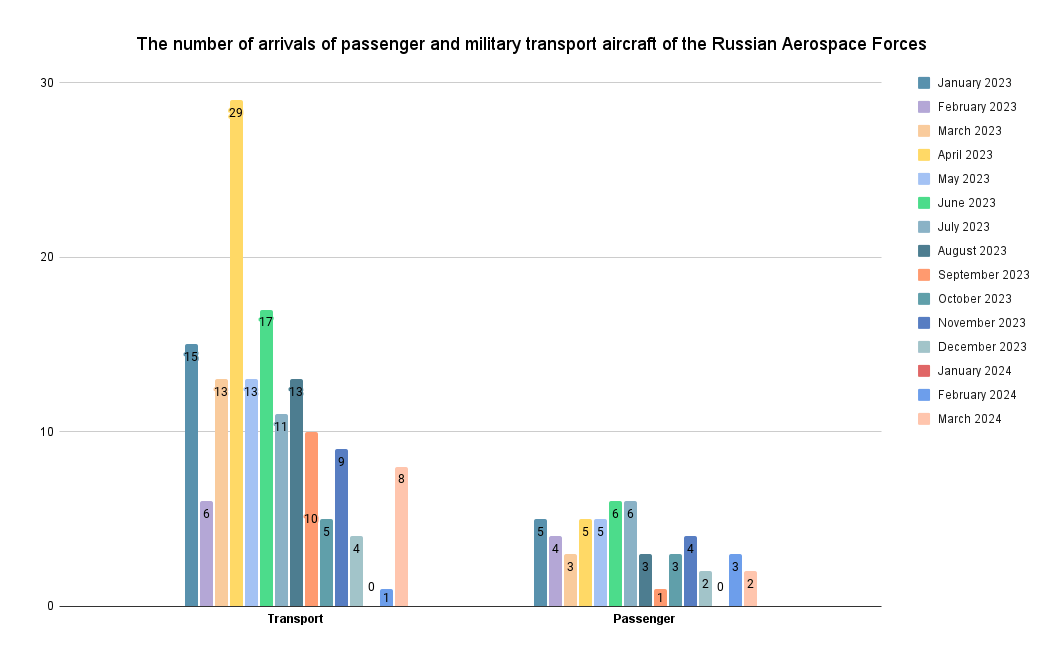
We should separately mention the arrival of the An-26KPA calibration equipment aircraft of the Russian Aerospace Forces in Belarus. On March 15-22, this aircraft was checking radio-technical systems at Homiel airport.
An-26KPA is a special laboratory aircraft that checks the operation of ground-based radio-technical flight support facilities, aviation telecommunications, lighting and signaling equipment systems.
Such inspections of airfield (airport) equipment are conducted regularly. The previous time such aircraft was in Belarus from November 28 to December 29, 2023. At that time the radio technical systems of Machulishchy, Lida and Baranavichy airfields were checked.
It is notable that on its current arrival the aircraft is checking the radio technical systems of the civilian Homiel airport. This may indicate plans to actively use the airport for the transfer of military cargo (as has already happened in 2022-2023).
We can also note that on March 12, 14, 19, 21 and 26, flights of fighters of the Russian Aerospace Forces were recorded at Baranavichy airfield. In addition to fighters, flights of the Su-24MR reconnaissance aircraft of the Russian Aerospace Forces were recorded on March 21 and 26.
We received no information on the changes in the number of the Russian Aerospace Forces aviation group during the month. As of April 1, the following aircraft of the Russian Aerospace Forces are permanently stationed on the territory of Belarus:
- at Lida airfield – one Su-25 attack aircraft;
- at Baranavichy airfield – two Su-24M/MR aircraft and at least one Su-30SM fighter.
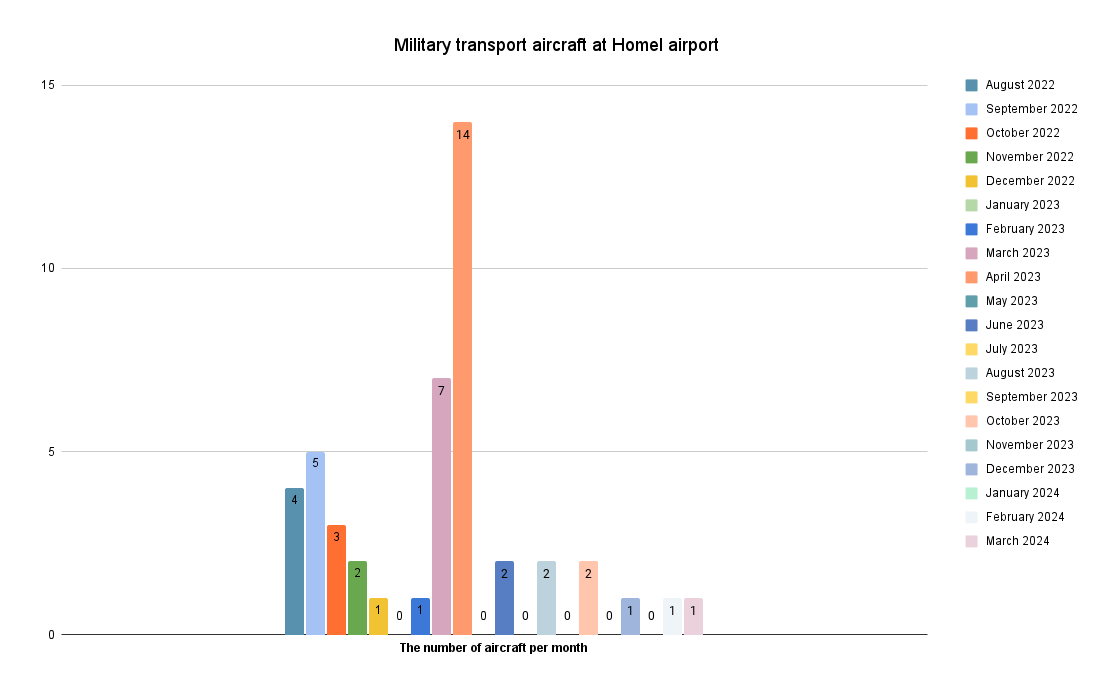
One An-12 military transport aircraft of the Russian Aerospace Forces arrived at Homiel airport in March. Prior to that, a Russian aircraft arrived at the airport in February. The dynamics of arrivals of the Russian Aerospace Forces aircraft from August 2022 to March 2024 can be seen in the chart.
3. Wagner private military company
The situation with the mercenaries in Belarus hasn’t changed significantly compared to February.
We can state that after Lukashenka’s statements about the need to stop praising PMC Wagner, there was a change of media policy with regard to the mercenaries. Recently, the number of references to PMC Wagner by official resources has significantly decreased.
Information about the beginning of construction of a residential building for the mercenaries of PMC Wagner and their family members, who stayed in Belarus, was spread. The residential building is to be built in Tsel village, where a camp for the mercenaries was built in 2023. We note that so far there have been no signs of the beginning of construction of the residential building.
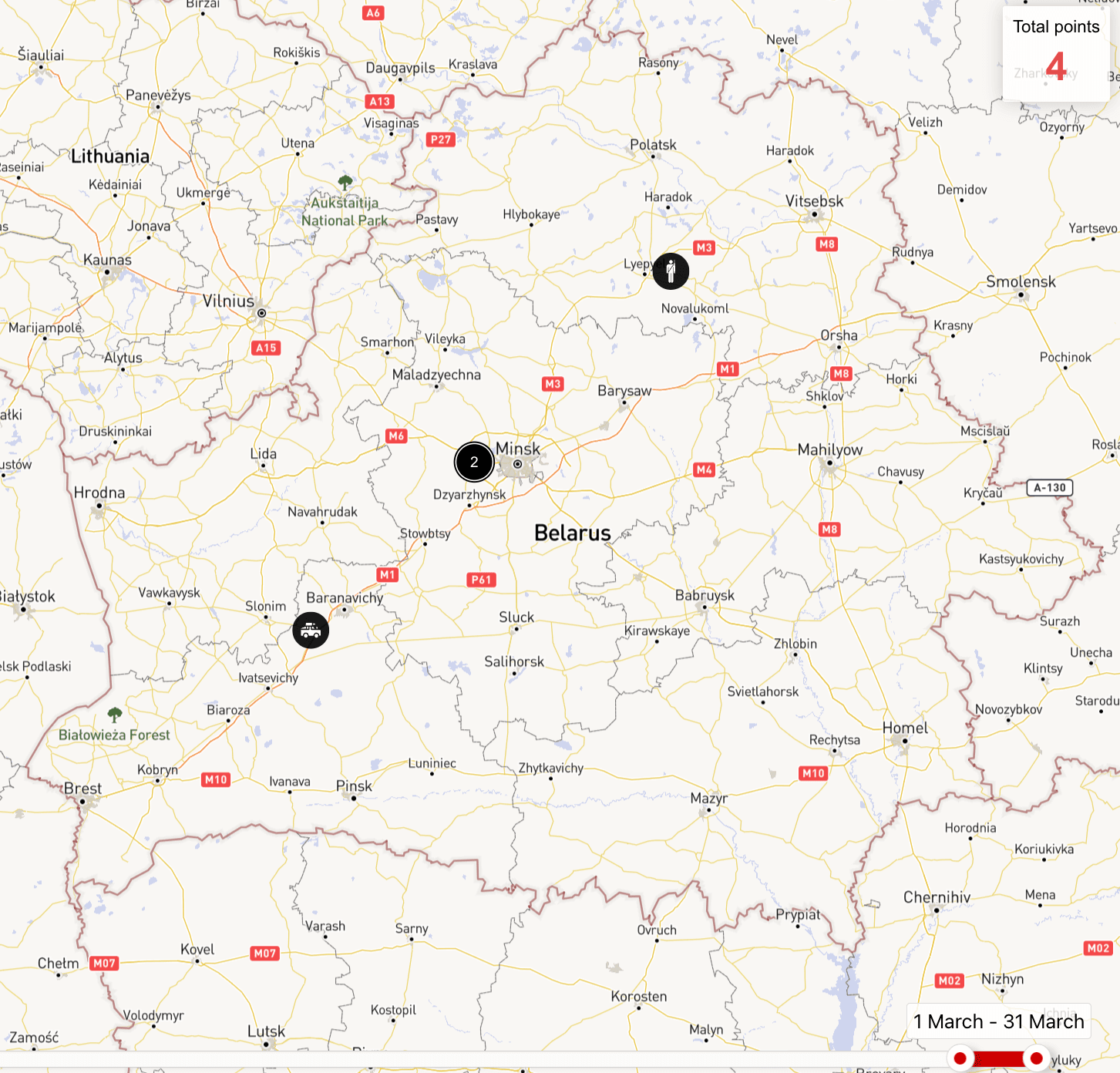
There was also information about the forthcoming amendments to the Belarusian legislation, which would allow foreign citizens to enter military service under contract in the Belarusian Armed Forces and the Internal Troops. Earlier we have repeatedly written that some of the mercenaries of PMC Wagner were integrated into the security forces of the Lukashenka regime as full-time instructors. The described method of possible legalization of the mercenaries is understandable and logical. It should be noted that the mercenaries have been in Belarus and have been working with the security forces for about 9 months. But the issue of their legal stay and work is planned to be solved only now. It is possible that these issues could be a secret normative legal act (for example, a decree), which was not published.
The number of the mercenaries in Belarus could be estimated at hundreds of people. As before, the mercenaries continue to train Belarusian security forces. The special feature of recent months is the intensification of cooperation of the mercenaries with the Belarusian Armed Forces (for more details, see paragraph 1.1 of the review).
4. General conclusions
1) The main event of March for the Belarusian Armed Forces was the combat readiness inspection. We can state that for the first time the mobilization expansion (i.e. transfer of troops to wartime organization and staffing with additional personnel, removal of military equipment from storage, etc.) of two Belarusian Armed Forces formations at once – a mechanized and an anti-aircraft missile brigades – is being practiced. The number of reservists drafted to training sessions is also unprecedented in terms of scale – 6000 people. For comparison, the Ministry of Defense of Belarus planned to draft 9000 reservists to training sessions for the entire 2023.
The transition of a mechanized brigade from peacetime to wartime was first practiced in 2023 with the 11th Mechanized Brigade. However, the events of 2024 have some differences. For example, in parallel with the expansion of the 19th Mechanized Brigade, some of its units were redeployed to cover the Lithuanian border. Simply put, while some units are covering the border during the threatening period, other brigade units are expanding in the rear.
In general, after the beginning of Russia’s full-scale invasion of Ukraine, Belarus began to pay more attention to the issues of mobilization expansion of both the Belarusian Armed Forces and territorial defense units. Here we can recall, for example, the verification of military registration data of all reservists. Updating the data on reservists allows to perform the tasks of mobilization expansion of the Belarusian Armed Forces units more efficiently. This experience was adopted by the Russian military from Belarus.
Tentatively, the combat readiness inspection will continue until the end of April. Then it will be possible to speak definitively about its results.
These measures can be explained both by the Lukashenka regime’s consideration of the experience of mobilization in Russia and Ukraine and by the increased (in the regime’s opinion) probability of participation in a real war.
2) The general conclusion about the situation with the Russian Armed Forces on the territory of Belarus didn’t change. All the conclusions given in the review for February remain valid.
The level of activity of the Russian Armed Forces in Belarus in March could be described as very low.
3) All the conclusions regarding the prospects for the deployment of PMC Wagner mercenaries in Belarus given in the review for October 2023 remain valid. A small number of the mercenaries are still stationed in Belarus, who serve as instructors for Belarusian military structures. There are no signs of a complete shutdown of mercenaries’ activities in Belarus.
The level of activity of PMC Wagner in Belarus in March could be described as low.
